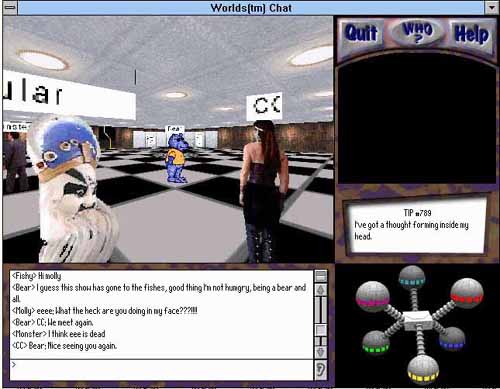BIBLIOGRAPHIC REFERENCE:
Written September 1995
by Bruce Damer, Christina Kekenes, Terrel Hoffman, submitted to ACM CHI
'96 and featured in Proceedings of the CHI '96 Conference Companion on
Human factors: Common Ground, Demonstrations, ACM
Press, New York, New York, ISBN:0-89791-832-0, pp. 9-10. Find
the ACM
Portal Digital Library Reference Here.
ABSTRACT
The emergence of standards such as Virtual
Reality Modeling Language (VRML) has made shared, three dimensional virtual
spaces available to the greater Internet community. When these spaces become
inhabited by representations of people, often referred to as digital actors
or avatars, a whole spectrum of social behavior will emerge. Prototypes
of inhabited digital spaces have been hosted on the Internet since early 1995.
Enough experience has been gained with these systems to produce an initial
benchmark of their effectiveness from a user interface standpoint. Observation
of social interaction in these spaces has also provided some interesting insights.
A key finding is that there is a need for interdisciplinary collaboration
between the technologists building digital worlds and specialists in community
and social behavior.
Keywords
virtual reality, social computing, electronic community
INTRODUCTION
The inhabited digital space is a newly emerging medium of human interaction.
This medium is born of the combination of two technologies, virtual reality
and text-based chat environments such as Multi-User Domains (MUDs). Virtual
reality has brought real-time three dimensional scenes to life on commonly
available computer hardware. A growing number of MUDs and other text-based
chat environments have brought a novel form of interactive community to users
on networks such as the Internet. Several prototypes which combine elements
of graphical virtual reality and text chat are now being hosted on the Internet.
These prototypes allow users to manipulate a digital actor or avatar in the
graphical space while communicating with others (also represented by avatars)
using a text-based chat interface.
THE PROTOTYPES TESTED AND UNDER STUDY
Members of the Contact Consortium have been testing and studying several
of these prototypes since early 1995. Prototypes tested include WorldsChat
[1] (Figure 1) and Alpha World [2].
Systems under study include Distributed
Interactive Virtual Environment (DIVE) [3], Starbright World [4], and
Worlds Away [5]. Some of the prototypes
examined are scheduled for release as commercial services. We expect that
there will be an increased number of these systems available on the Internet
in 1996. We hope that this benchmark will engage the interest of researchers
and other contributors before the medium extends to the mainstream of computer
users.
Testing methodology
WorldsChat and Alpha World were tested extensively. To test, members of
the Consortium would enter a pre-arranged area in the virtual world with agreed
upon avatars and name badges. Cooperative walk-throughs of the spaces were
tried to test the ease of navigation and following ability. Conversations
were carried out between testers and other users in the environment. Interaction
with novice and experienced users was carried out to gage their impressions
of both the medium and its usefulness for interaction. Numerous screen shots
were taken of typical social situations. Video was shot of one session in
WorldsChat. Starbright World (still under development) was studied from videotaped
sessions supplied by its designers. DIVE and Worlds Away were studied from
the available literature and World Wide Web documentation and images.
Technical and user interface criteria
The prototypes had limitations in both performance and user interface. However,
due to their use of a natural, point-of-view metaphor, they were surprisingly
easy to navigate and engage other users in interaction. Very little in the
way of user training was necessary. Often, veteran users would coach new arrivals.
The technical and user interface criteria tested included:
- Appearance and rendering performance of graphics
- Avatar appearance and design (range of choices, badging, distance appearance,
articulation or animation)
- Ease, options for avatar motion (degrees of freedom)
- Ease of communication (text chat, body language)
- Effectiveness of controls and services (doors, stairs, walkways, rooms,
signage, coordinate readouts)
- Server crowd control effectiveness (speed of rendering other avatars,
collision detection)
- Ability of users to alter the space (object moving and assembly, building
construction, message posting)
- Special features offered in the world space (custom design of avatars,
community newspaper, feedback facilities)
Observations of interactions
Observations of social interaction within these virtual worlds posed some
challenges. We found that the lack of a number of important social cues lead
to frequent misunderstandings between users. Observation focused on:
- Tracking threads of conversation between individuals
- Noting differences in interaction between the observer and newcomers or
veteran participants
- Observing occurrences of aggression or cooperation, either communicated
through text or by motion of the users' avatars
- Interaction with participants on their reactions to the environment and
its effectiveness
- Observing the use of special terms in the environment

Figure 1. Scene from WorldsChat showing close range chat interaction
with other users represented as avatars.
CONCLUSIONS
While the early prototypes suffered from both user interface and communication
limitations, we were able to carry out meaningful interaction within these
digital spaces. This medium may become effective as a tool for social interaction
and cooperative work. Some initial areas in need of improvement are discussed
below.
Improved graphics rendering and server crowd control speed would reduce
the effort required to navigate and approach other avatars for interaction.
Auditory cues when collisions occur would reduce confusion. Finally, a set
of simple, standard interface cues for navigating in virtual space would be
very useful. Some suggestion of how these cues might work is discussed by
Slater, Usoh, and Steed in [6].
There are limitations that prevent the full expression of interaction, for
example, because avatars are not unique to each user, it is difficult to distinguish
between strangers and familiar users. Lastly lacking a means to identify who
is involved in a conversation leads to frequent inadvertent interruptions.
Some of these issues are addressed by Benford, Bowers, Lennart, and Greenhalgh
in [3].
To facilitate improvements and overcome these limitations, we feel that
there is a need for strong inter-disciplinary cooperation. Of particular importance
is the involvement of social scientists and specialists in community in the
process of design and testing of this emerging new medium of human interaction.
REFERENCES
1. Smith, G., Living in the Virtual World: Phase One, in Popular Science
(October 1995), Times Mirror Magazines: New York NY, p. 42.
2. Desmond, M., The Shape of Things to Come: Alpha World Brings a 3-D Virtual
World to the Internet, in Multimedia World (September 1995), pp. 16-17.
3. Benford, S., Bowers, J., Lennart, F. E., Greenhalgh, C. Managing Mutual
Awareness In Collaborative Virtual Environments, in Proc. VRST'94 (Singapore,
1994), World Scientific: Singapore, pp. 223-235.
4. Spielberg Launches Virtual Environment, in Southern California Micro
Publishing News (July 1995), Micro Publishing Press: Torrance CA, pp.
1, 37.
5. Worlds Away, in VR World (July/August 1995), Mecklermedia Corp:
Westport CT, p. 9.
6. Slater, M., Usoh, M., Steed, A., Steps and Ladders in Virtual Reality,
in Proc. VRST'94 (Singapore, 1994), World Scientific, pp. 45-54.
(c) Copyright on this material is held by the authors (1996).
Back to Papers
Index


